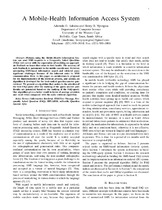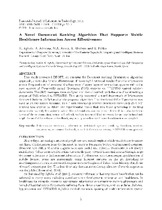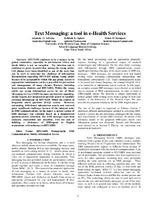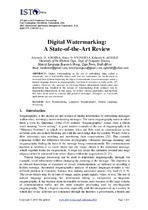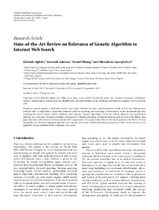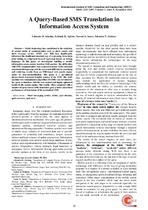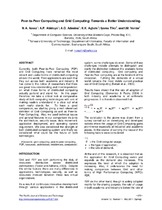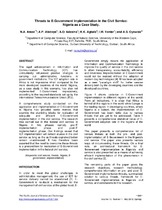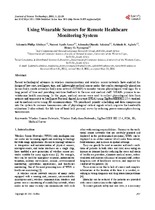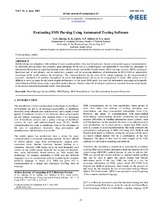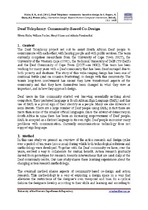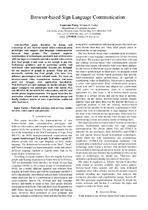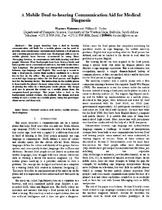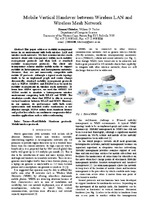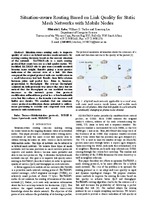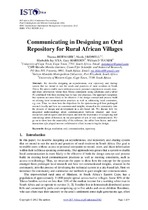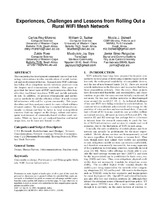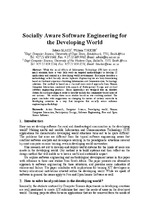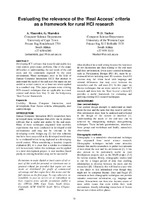Research Articles (Computer Science): Recent submissions
Now showing items 101-120 of 170
-
A Mobile-Health Information Access System
(Telkom, 2013)Patients using the Mobile-Health Information System can send SMS requests to a Frequently Asked Questions (FAQ) web server with the expectation of receiving an appropriate feedback on issues that relate to their health. ... -
A novel document ranking algorithm that supports mobile healthcare information access effectiveness
(Academic Journals Inc., 2011)This study presented DROPT; an acronym for Document ranking Optmization algorithm approach, a new idea for the effectiveness of meaningful retrieval results from the information source. Proposed method extracted the frequency ... -
Text Messaging a tool in e-Health services
(Telkom, 2010)HIV/AIDS continues to be a menace to the global community, especially in sub-Saharan Africa and South Africa is not an exception. The infection rate is continues to grow, in particular, among the young adults. Cell ... -
Digital watermarking: a state-of-the-art review
(IIMC International Information Management Corporation, 2010)Digital watermarking is the art of embedding data, called a watermark, into a multimedia object such that the watermark can be detected or extracted later without impairing the object. Concealment of secret messages inside ... -
State-of-the-art review on relevance of genetic algorithm to internet web search
(Hindawi Publishing Corporation, 2012)People use search engines to find information they desire with the aim that their information needs will be met. Information retrieval (IR) is a field that is concerned primarily with the searching and retrieving of ... -
Fast tracking students from disadvantaged backgrounds into main stream Computer Science
(Computer Society of South Africa, 2000)A computer-based training (CBT) system was used to teach Computer Literacy to full-time students at the University of the Western Cape. This approach was successful in creating computer literate students as well as creating ... -
A query-based SMS translation in information access system
(Blue Eyes Intelligence Engineering & Sciences Publication Pvt. Ltd., 2011)Mobile technology has contributed to the evolution of several media of communication such as chats, emails and short message service (SMS) text. This has significantly influenced the traditional standard way of expressing ... -
Peer-to-Peer Computing and Grid Computing: towards a better understanding
(Akamai University, 2011)Currently, both Peer-to-Peer Computing (P2P) and Grid Computing have remained the most vibrant and useful forms of distributed computing all over the world. Their applications are such that they cut across both academia ... -
Threats to e-government implementation in the civil service: Nigeria as a case study
(Akamai University, 2012)The rapid advancement in Information and Communication Technology (ICT) has undoubtedly influenced positive changes in carrying out administrative functions in government institutions. The ICT adoption rate in Africa is ... -
Using wearable sensors for remote healthcare monitoring system
(Scientific Research Publishing, 2011)Recent technological advances in wireless communications and wireless sensor networks have enabled the design of low-cost, intelligent, tiny, and lightweight medical sensor nodes that can be strategically placed on human ... -
Evaluating SMS parsing using automated testing software
(Institute of Electrical and Electronics Engineers (IEEE) Inc., 2012)Mobile phones are ubiquitous with millions of users acquiring them every day for personal, business and social usage or communication. Its enormous pervasiveness has created a great advantage for its use as a technological ... -
Deaf telephony: community-based co-design (case study)
(Wiley, 2011)The process of community-based co-design is one that explores various solution configurations in a multi-dimensional design space whose axes are the different dimensions of requirements and the various dimensions of designer ... -
Browser-based sign language communication
(Telkom, 2010)This paper describes the design and evaluation of two browser-based video communication prototypes that support sign language communication between Deaf people. The research explores combinations of technologies, protocols ... -
A mobile Deaf-to-hearing communication aid for medical diagnosis
(Telkom, 2010)This paper describes how a deaf to hearing communication aid built for a mobile phone can be used to provide semi-synchronous communication between a Deaf person and a hearing person who cannot sign. Deaf people with access ... -
Mobile vertical handover between infrastructure and ad hoc Wi-Fi networks
(Telkom, 2011)This paper addresses mobility management issues in an environment with both wireless LAN and wireless mesh networks. We first examine wireless mesh network client side transparency within mesh mobility management protocols ... -
Situation-aware routing based on link quality for static mesh networks with mobile nodes
(Telkom, 2011)Situation-aware routing seeks to improve quality of service on hybrid wireless mesh networks by making routing decisions based on the current situation of the network. BATMAN-adv is a mesh routing protocol that counts ... -
Communicating in designing an oral repository for rural African villages
(IIMC International Information Management Corporation, 2012)We describe designing an asynchronous, oral repository and sharing system that we intend to suit the needs and practices of rural residents in South Africa. We aim to enable users without access to personal computers to ... -
Experiences, challenges and lessons from rolling out a rural WiFi mesh network
(ACM, 2013)The DEV community knows that technology interventions involve consideration of social and environmental factors as much as technical ones. This is particularly true for the introduction of communications infrastructure in ... -
Socially aware software engineering for the developing world
(IIMC International Information Management Corporation, 2006)While the social effects of Information Technology (IT) have received much attention there is very little work on targeted methodologies to develop IT applications and content in a developing world environment. This paper ... -
Evaluating the relevance of the “Real Access” criteria as a framework for rural HCI research
(ACM, 2006)Developing ICT software that is useful and usable in a rural context poses many problems. One of the major difficulties is understanding the real needs of the target users and the constraints imposed by the rural environment. ...

